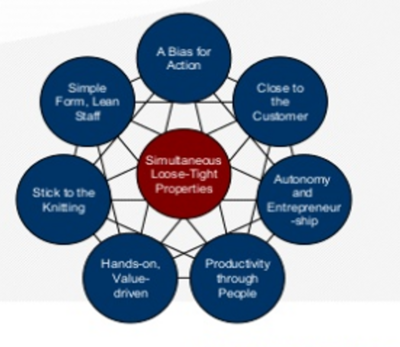Attributes of Management Excellence
In their book, In Search of Excellence: Lessons From America’s Best-Run Companies, Robert H. Waterman, Jr., and Thomas J. Peters, Ph.D., describe the framework of eight common attributes of excellence which they identified as being responsible for the success of companies they termed as excellent: Here are the practices found in each “excellent company.”
- A Bias for Action— The “ready, shoot, aim” philosophy. No “paralysis by analysis.” Lots of small, experimental trials, learn from the inevitable mistakes, and try again. Fail fast. Communicate, communicate, communicate.
- Get and Stay Close to the Customer – Customers “intrude” in every nook and cranny of the company, are highly valued, and are often considered partners or stakeholders. There is an obsession with quality, reliability, and customer service. Customers truly are Queens and Kings, not “necessary evils.”
- A Mindset of Autonomy and Entrepreneurship – Primary responsibility for innovation is pushed to the front lines. Risk-taking, “boot-legging,” and “championing” are encouraged.
Employees are not penalized when things go wrong. Successful product or program champions rise quickly up the ranks.
- Productivity Through People – The ideas and actions of the front-line workforce, customers, and suppliers are the main source of productivity gains. “Treat all employees as adults, as partners, with dignity, and show respect.” (p.238) Provide job security and safety. Broadly share gains from productivity improvement.
- Be Hands-on and Value-Driven – “Every excellent company we studied was clear on what it stands for, and takes the process of shaping values seriously…We wonder if it is even possible to be an excellent company without clarity of the right sorts of values.” (p. 280) Two common key values were striving to be the best, and delivering superior quality and service. Leaders are highly visible and close to the front-lines.
- Stick to the Knitting – Robert Wood Johnson, founder of Johnson & Johnson, said “Never get into businesses you don’t know thoroughly or know how to run.” (p.299) The excellent companies expanded and diversified primarily internally, one small, manageable step at a time. Contain risks and get out if not working.
- Simple Form, Lean Staff – One employee, one boss. The “flat organization.” People know who they report to. Organization realignments are rare. Responsibility for results, along with commensurate authority and resources, is pushed far down the line. Warren Buffett is said to require just one piece of paper from his division presidents prior to the next fiscal year with just two numbers to which they commit: Revenues and Net Profits Before Taxes. This “elaborate planning” seems to have worked out pretty well for him. How about you?
- Simultaneous Loose-Tight Properties –The key values of the organization (Quality, Service, Ethics, and so on) are articulated and known. All employees are charged with tightly adhering to them, but employees are given wide latitude (loose) as to how the daily business is done. A “cookie cutter” approach is rare.[1]

source: Flevy.com
References
